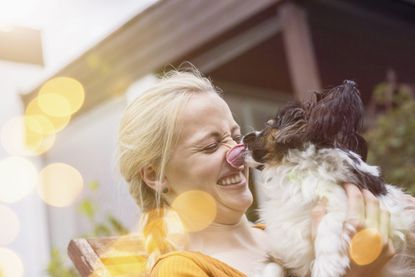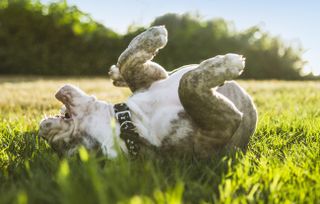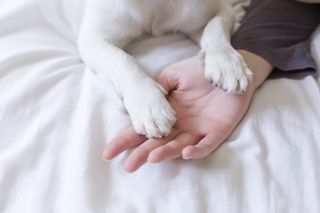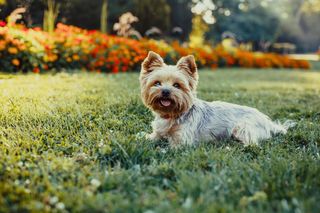Why does my dog eat grass? 10 weird dog behaviours explained
We love walkies and belly rubs. But sometimes we have no idea why a pooch does what they do, like eating grass and rolling in poo, just why?


We're a nation of dog lovers, from bulldogs and labradors, to whippets and pugs, we love walkies and belly rubs. But sometimes we have no idea why a pooch does what they do, like rolling in fox poo and eating grass, just why?
Dogs are hard work, with many parents comparing life with a puppy to having a newborn baby all over again. So, it makes sense that as dog owners – parents – you instinctively know when something is a bit off with your furry favourite.
A limp tail, trembles and excessive sneezing can all be cause for concern, lucky for us though, dogs have their own ways of communicating – a paw here, lick there, but pinpointing exactly what’s wrong can be difficult. If you’re constantly muttering ‘but… Why does he do that?’ about your pet pooch, then read on, we’ve grilled the dog experts at Canagan on the most commonly pondered questions.
1) Why does my dog eat grass and rocks?

Does your dog seem more interested in eating grass, than running around in it? This is a condition called Pica, and is also seen in humans when there is a desire to eat non-food objects. Canagan's expert, veterinarian Henry Dove, says: “if your dog is eating grass, this could be caused by boredom, pain or possible nutritional deficiencies.
“Great care must be taken with dogs eating stones as well as grass, as these can not only damage teeth but also cause serious problems with the digestive system.
“Both grass and stones can cause blockages in the intestines which will sometimes need major surgery to correct, so care must be taken if your dog is prone to eating both grass and stones.”
2) Why does my dog lick me?

Dogs have highly sensitive sense receptors in their mouths that they use to gather information about their environment to keep themselves and their pack safe. When you become a dog owner you become part of their pack, and dogs lick members of their pack - and themselves - for various reasons. Here are a few:
GoodtoKnow Newsletter
Parenting advice, hot topics, best buys and family finance tips delivered straight to your inbox.
Affection: Licking a loved one releases endorphins in your dog that calms and comforts them.
Attention: Your dog wants you to notice them, feel your love and show it back.
We taste good: Dogs enjoy the salt on our skin and can also pick up tiny food particles.
Mood gauging: Licking your sweat may be an attempt to ‘taste’ your mood. Our sweat and sebaceous glands secrete a cocktail of salts and waste products that enable dogs to detect our mood.
Communication: If your pooch is licking you intensely, scan the room to ensure nothing is amiss like an empty water bowl or a closed door. They may need a drink or the toilet.
Soothes them: If your pooch is feeling stressed, licking you (especially your feet) can help
Shows submission: Licking your feet is a sign that your pet acknowledges the social order of your home, with you as master. Though, if you want your pet pooch to stop licking you, simply ignore them and walk into another room. They’ll soon learn that licking causes you to leave, which is the last thing they want.
3) Why does my dog lick himself?
A dog licking himself is not unusual, they like to groom and keep themselves clean. However do keep on eye on how often and how intensely they lick themselves as it could signify underlying issues.
Gland issues: Excessive licking and cleaning in the anal area signals that their glands need to be expressed.
Anxiety: Excessive licking in the same area of their body may signify that your pet is scared or nervous.
Healing: Dog saliva contains enzymes that can kill bacteria and remove dead tissue. The risk of licking a healing wound however, is that it’ll re-open, inviting infection.
4) Why does my dog stare at me?

As with licking, staring is a form of communication. Those puppy dog eyes might be trying to tell you something, such as they’re hungry they need to go for a walk or they might be after praise or direction, dogs can look closely to detect emotion in our facial expressions.
Though bear in mind that there isn’t always a motive behind staring. If you’re training your dog, encourage them to stare while awaiting your cues.
This reciprocal gazing is encouraged within the context of a healthy dog-human relationship unaffected by aggression; otherwise, an uncomfortable dog may perceive this as a challenge or stand-off.
READ MORE: Your pets sleep position reveals how they REALLY feel about you
5) Why does my dog put his paw on me?

As with licking and staring, using their paw is another form of communication for your dog. The paw may signify;
Attention: You might respond by offering a tummy rub or patting their head. When you stop, they’ll paw again, wanting further petting– and so goes the cycle. Be mindful of how often you give into these pawing demands, before it becomes an annoying habit.
To initiate play: You may also witness your pet pawing other dogs. If their fellow canine reciprocates, they have agreed to play.
6) Why does my usually placid dog rip apart squeaky toys?
It’s always worth remembering that even though your dog is a beloved family pet, domestic dogs are descended from wolves, so playing with (and ripping apart) squeaky toys satisfies their natural hunting instincts.
When a wolf captures small animals in the wild, it vigorously shakes it – with small animals making squeaking noises in the process. This sensory experience of playing with a squeaky toy may appeal to your pet because it’s akin to hunting and killing prey.
Many dogs will dive in for the squeaker before tiring of a toy, while others enjoy pulling the stuffing out and proudly spreading it around.
7) Why does my dog howl?
It all comes down to primal ancestry. If your dog howls, this may be why:
In response to an environmental trigger: Noises like a siren, musical instrument or singing can sound strikingly like a fellow dog (or wolf) howl.
To say “I’m here!”: In the wild, dogs send out vocal beacons to help members of their pack find their way back. Your pup may be feeling stressed, anxious or want to play with you or another dog – and a hearty howl is sure to grab attention.
In pain: Just as people cry, dogs may howl if they are hurting.
In pursuit: If your dog is chasing a smaller animal, instinct might tell them to send a signal far and wide.
Defending their territory: A howl can act as a warning, as your dog enforces their physical boundaries.
8) Why does my dog roll in other animals’ poo?
While it sounds disgusting it’s totally natural and a very common behaviour in dogs. A few reasons might be:
Primal: Again, those wolf instincts may drive your dog to mask their scent so they can better sneak up on ‘prey’. Or, contrastingly, camouflage their own odour in case larger predators are lurking.
Communication: It’s your furry friend’s way of communicating to ‘pack members’ where they’ve been and what they’ve been up to.
All Natural: If you’ve recently bathed your dog they may not like the smell of perfumed shampoo
It's fun!: Rolling in reckless abandon on a walk can really brighten a dog’s day.
9) Why does my dog do that with their tail?

The tail offers up so much information about a dog. While it’s well know that an energetic wag of the tail is the sign of a happy pooch there are many other signals they’re trying to give, such as;
Raised tail: A dog is feeling alert, excited or dominant.
Low tail: The more anxious or submissive your pet is feeling, the more tightly they will tuck their tail close to their body. If in pain, or exhausted from exercise, a dog may carry their tails lower than usual.
Neutral tail: They’re feeling relaxed. Dogs with curly tails, like pugs, unravel their tails when resting.
Tense tail: If held rigidly, your pet is alert and likely to react to their surroundings. If they feel agitated, their tail may ‘fluff up’ with fur standing on end.
Flicking back and forth: This is known as ‘flagging’, a threatened dog may be ready to attack so interfering is ill-advised.
It’s important to remember that a ‘normal’ tail varies depending on the breed, such as Chow Chows naturally have high, curved tails, while whippets have a lower tail carriage. Your knowledge of your dog’s personality can help you understand if they are happy or sad, threatened or relaxed, in relation to their tail activity.
However, there’s no guaranteed way of knowing exactly how your dog is feeling – tail movements must always be taken into consideration with the overall behaviour of a dog.
10) Why does my dog shake?
Shivering isn’t just about the chill in the air. If your pet pooch has the shakes it could be a sign of one of these; Thermoregulation (temperature control)
When the body senses lowering temperature, it shivers to generate body heat. When a dog has a fever, their body’s thermostat resets to a higher temperature. As this drops back down to normal, shivering occurs to restore the new elevated temperature. If you’re worried, take their temperature – 38-40 degrees Celsius is considered normal. If you sense a fever, seek veterinary attention.
Heightened emotion: Whether it’s excitement, anxiety or fear, emotional responses can manifest physically as trembling. Always check the environment you’re in, in case something is causing your dog to feel anxious and remove the source of stress to see if the trembling subsides.
Pain: If your dog is experiencing trauma or physical pain, they may tremble. Be mindful that not all dogs tremble in response to pain – it’s one symptom that emerges in some
Disease: Trembling may signify various medical issues, like kidney failure, muscle diseases and neurological disorders, but always consult with a vet before fearing the worst.
Toxins: Certain foods substances, like chocolate, can be harmful to dogs. Trembling is an early neurological symptom.
Muscle weakness: Common in older dogs, weakening muscles can cause trembling.
However, if any trembling continues for 1-2 hours, seek veterinary advice. Symptoms like lethargy, loss of appetite, vomiting and diarrhoea may indicate a health issue. The sooner this is addressed, the more likely your pet will return to their happy, healthy selves.
While looking out for signs can help, you know your dog and if you’re worried about anything at all, always go to your vet.

Stephanie Lowe is Family Editor at GoodToKnow covering all things parenting, pregnancy and more. She has over 13 years' experience as a digital journalist with a wealth of knowledge and experience when it comes to all things family and lifestyle. Stephanie lives in Kent with her husband and son, Ted. Just keeping on top of school emails/fund raisers/non-uniform days/packed lunches is her second full time job.
-
 Compromising may be killing your relationship - here are 5 ways to reach healthy compromises, according to relationship expert
Compromising may be killing your relationship - here are 5 ways to reach healthy compromises, according to relationship expertCompromising isn't always the best way to keep the peace in a relationship
By Charlie Elizabeth Culverhouse Published
-
 Best interactive pets for kids: 15 gift ideas for children of all ages
Best interactive pets for kids: 15 gift ideas for children of all agesFrom puppies to axolotls, take a look at our selection of the best interactive pets you can buy that are sure to be a hit with little animal lovers
By Sarah Handley Published